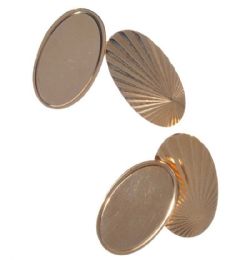If you’re struggling to find a gift your father, husband, brother, uncle, boyfriend, etc., consider the cufflink. For the dapper male, a pair of cufflinks is a welcome addition to his sartorial arsenal. For the dishevelled male, it’s a nudge in the right direction to slide out of student mode and into the world of serious dressing. And, with Christmas just around the corner, we thought we’d make things easy by creating a buying guide to help you in your search for the perfect pair.
Cufflinks rose to popularity in the 1800’s and have been a staple of men’s fashion ever since. In the 19th century, cuffs and collars — the parts of shirts that undergo the most wear and tear — were made stiffer for durability. Unfortunately, that also made them too stiff to secure with a simple button. While the first cufflink prototypes served very utilitarian purpose, the Duke of Windsor popularised more colourful versions in the early 20th century, making them one of the first pieces of jewellery acceptable for men to wear. Today, men’s cufflinks come in a wide variety of styles and materials.
Materials
The first decision to make — and one that will largely govern the price point — is material. Consider the environment of the wearer: Will he attend business meetings? Formal balls? Private clubs? The cufflinks should be appropriate for the intended venue and occasion. Generally, men’s cufflinks should match a wearer’s watch, but not match his tie or pocket square. Some of the most popular materials include:
Gold is a classic, but usually best suited for formal occasions. If you’re looking for an everyday option, you may want to consider a more understated and durable material.
Platinum is usually more expensive than gold as it’s stronger, more dense and more resistant to corrosion. It has a whiter appearance than silver or stainless steel and is also a bit heavier than both.
Rose gold gets its pinkish cast from being a mixture of gold and copper. Again, it’s best suited to formal events.
Stainless steel is a resilient metal with a classic silvery colour. Stainless steel is favoured for its versatility, relatively inexpensive price tag and the fact that it won’t tarnish or irritate the skin. Unlike other materials, stainless steel is not poured into a mould to make cufflinks. Instead, it is cut from a solid piece of metal, leaving no weak spots or seams.
Silver cufflinks typically come in two forms, pure silver and sterling silver. Sterling is a combination of silver and copper. Pure silver is incredibly lustrous, but is less durable than an alloy.
Silk and other fabric cufflinks are casual, colourful options that typically comes in cord and knot styles.
Enamel is great if you’re looking to add a splash of colour. The powdered glass is fused to create a smooth and durable glossy material.
Precious stones — carnelian, onyx, mother-of-pearl and lapis lazuli are all common — all add a bit of flair when set in metal cufflinks. Prices can vary widely depending on the stone used.
Styles
After deciding on a material, the next step is to choose a design. Here are a few of the most common styles:
Toggle closure, also known as bullet back, is the most common style of cufflink today and consists of a swivel bar hinged between two posts. Turn the bar parallel to the posts when inserting through the button hole, then turn it 90 degrees to fasten.
Whale back cufflinks work similar to toggle closures but feature a single post connected to a flat tail by a hinge.
Ball return and stud cufflinks have no moving parts. They have fixed backs that are more secure than toggle closures and whale backs, but they are more difficult to put on.
Chain link and double panel cufflinks are the most traditional styles. They feature two identical heads held together by a metal chain.
Cord and knot styles are mostly limited to fabric cufflinks. They feature two knotted ends held together by a piece of the material used to make them.
Piqued your interest? Shop for new, vintage and antique in our online jewellery auctions.

